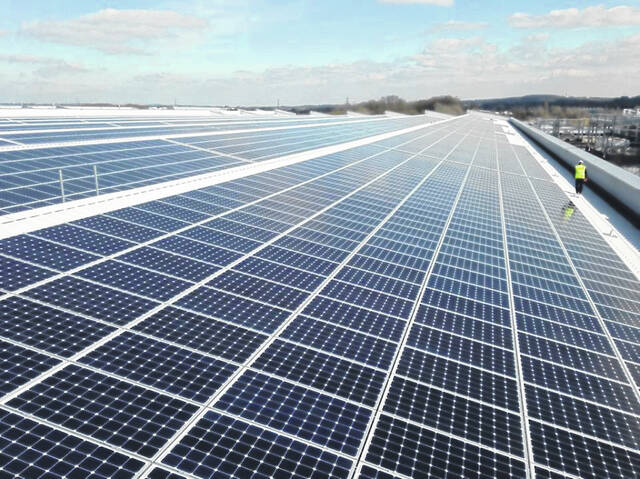A nonprofit group is seeking a temporary moratorium on the leasing of Bartholomew County agricultural lands for solar farms as the county prepares to consider “commercial solar regulations.”
The group, Bartholomew County Citizens Concerned about Commercial Solar Fields (B4CSF), is seeking a halt to the construction of large-scale solar energy plants until a community discussion can be held regarding its impact, group member Matt Carothers said.
The results of that discussion should help determine whether Bartholomew County should have an ordinance to go along with conditional use standards for solar farms, he said.
Talks get underway soon when the topic of “Commercial Solar Regulations in Bartholomew County” is discussed by the Bartholomew County Plan Commission on Wednesday. The 8:30 a.m. meeting will be held in the first floor meeting room at Columbus City Hall.
Additional discussions will take place when a solar field developer requests a mandatory conditional use permit from the county’s Board of Zoning Appeals. All requests for large-scale installations must be held during a public meeting in front of the BZA before solar field developers can proceed, Columbus/Bartholomew County Planning Director Jeff Bergman said.
But if any solar company asks to meet with the three Bartholomew County commissioners, their request will be denied, commissioner’s Chairman Carl Lienhoop said.
“We don’t want (solar companies) coming in here and trying to sell us that you’re good for us in Bartholomew County,” Lienhoop said. “We’ll make that determination on our own.”
Carothers said he’s been told the three commissioners will not consider a temporary moratorium on solar power installations. But he added they might change their minds.
B4CSF member Tim McNealy, an assistant C4 director in Columbus and Clay Township farmer, says the following four rural neighborhoods are being targeted by what he describe as “large solar facility developers:
Northern Clay Township (with 3,032 acres obtained with 30-year leases)
Mineral Springs Area (with 940 acres of recorded leases)
Owners of nearly 1,400 acres residing east of U.S. 31 South and along State Road 9, near Rockcreek Elementary School, have been contacted.
Approximately 1,600 acres in the Jonesville area are being sought.
Members of B4CSF emphasize they are advocates of clean power like wind and solar, but also believe the solar arrays should be confined to areas such as brownfields and land adjacent to industrial parks. Panel manufacturers such as Oya Solar suggest the land should be flat and cleared with minimal wetlands and within close proximity to three-phase power and a transmission substation.
There are 3,032 acres of land in Bartholomew County that have recorded land leases obtained by a solar power company, McNealy said. A number of farmers have been approached by two companies identified by the group as Carina Solar LLC and Tenaska Solar XVIII LLC.
The following is what B4CSF members feel will be placed at risk by large solar power installations in Bartholomew County:
“Value of homes. Field tiles. Scenic views. Sounds of nature. Proper water flow. Land use for future crop farming. Sandhill Crane migration routes. Wildlife habitat including pollinator areas such as bees and butterflies. Bald Eagles – finicky about where they nest. Fields of oxygen-producing plants – more oxygen produced in summer months than Amazon rain forest! The livelihood of local farmers’ money raising crops. Local agri-business suppliers. Neighboring properties: tornadoes, straight-line wind, and hail can damage panels.”
Matt Kasper, deputy director of the Energy and Policy Institute looked over both the B4CSF website and Facebook page and said a number of concerns expressed by group members appeared to contain a degree of misleading information cited frequently by the fossil fuel industries.
“I don’t see any links or resources to back up their claims,” said Kasper, who’s organization serves as a watchdog group organized to expose attacks on renewable energy, as well as to counter misinformation. The $2.3 trillion oil, coal and gas industry has established several front companies with reputable-sounding names that ultimately provide answers that are self-serving answers for fossil fuel corporations, according to the institute’s website.
Another concern from retired teacher, B4CSF member and farmer Henry Wischmeier regards the potential damage to solar panels that might be caused by straight-line winds, hail and tornadoes. According to the U.S. Environmental Protection Agency, storm damage is more likely to occur to panels five years or older.
Wischmeier also expressed concerned about the difficult of locating a landfill that would accept end-of-life solar panels. However, the federal government says finding landfills for old panels won’t be a problem for long. The cumulative value of recoverable raw materials from end-of-life solar panels will be about $450 million by the end of this decade, according to the EPA. That is equivalent to the cost of raw materials currently needed to produce about 60 million new panels, the government agency states.





